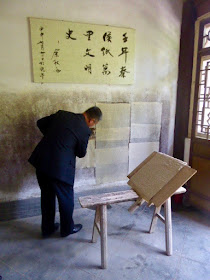Scrolls of papyrus and bamboo shoots were cumbersome and heavy, silk was expensive. Cai Lun (61-121 A.D.) developed the solution, paper, and civilization has been grateful ever since.
Grateful, but forgetful. Cai Lun, ranked by experts as the seventh most influential man in history, is virtually unknown in the West. The Good Girls certainly had never heard of him and neither had our fellow writers and photographers who were along on this Shaanxi adventure. That is until we were taken to Longting Town, given to Cai Lun by the grateful emperor and where he is buried.
 |
| Officials at Longting waiting to greet us. |
The story goes that on a rainy, muddy day, he had loaded a cart with important scrolls of bamboo strips to take home and read. En route the ox stumbled, the cart overturned and the scrolls fell out. As Cai Lun struggled to reload them, he decided there must be a better way to preserve documents.
There was. After much experimentation, he developed the methods for combining bark from trees, hemp, waste, old rags and fish nets, macerating and soaking it until it could be lifted out of the water and dried to form sheets of paper.
He showed it to the emperor who issued a decree that the whole country should adopt it. Cai Lun was given a new title, Marquis of Dragon Pavilion, and a village, which quickly became a center of paper making. His invention was called the Marquis Cai Paper.
Later, Cai Lun was accused of treasonous palace intrigue. Rather than go through an investigation, he bathed, dressed in his finest robe and took poison. Eventually he was absolved and reburied in a proper tomb.
The site is an humble one by comparison to others we had seen. You enter a memorial filled with
paper-making implements used during his lifetime,
a portrait
and scenes from his life and paper-making.
We toured through The Museum of Cailun Paper Culture next door to see Cai Lun's process at work.
From the collection of materials,
their soaking,
 |
| Debi tries out the maceration device. |
Once an even sheet can be screened out,
It is eased off the screen,
slapped on a wall to dry
The director showed us the final steps; in summer, regular demonstrations are offered. There is a small store were visitors can buy hand-made paper, with or without Chinese calligraphy.
Paper is considered one of China's greatest inventions along with gunpowder, the compass and the printing process.
We left with respect and great appreciation for Cai Lun, especially since none of us could have learned, developed and practiced our skills without his world-changing process.
.




















No comments:
Post a Comment